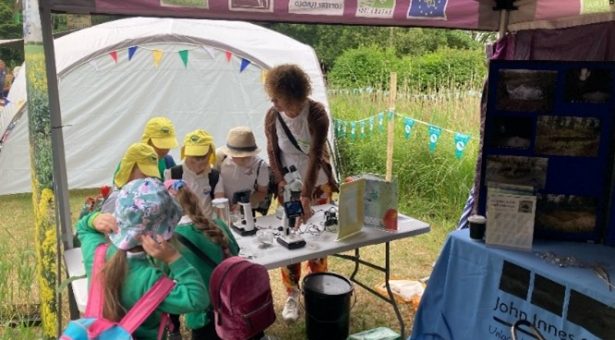After the Royal Norfolk Show – reflecting on a public outing for science and innovation

Face-to-face, hands-on science engagement has been difficult during pandemic-affected times. So it was with great enthusiasm that a scientific scrum of John Innes Centre researchers, staff and students headed to the Royal Norfolk Show.
The annual agricultural extravaganza – this year’s event attracted an estimated 90,000 visitors and 700 businesses – has been absent from the social calendar over the past couple of years. Its return in 2022 marked the 175th year and offered an unmissable opportunity to promote the region’s amazing innovation, food, farming and countryside.
The John Innes Centre had four exhibits and groups in attendance at the show. Here we dip into a few highlights.
Field Experimentation, farming and the environment in the ‘Broads Village’
In the specially recreated ‘Broads Village’ exhibit, delivered in collaboration with Natural England, we explained the experimental work carried out at the Dorothea de Winton Field Station at Church Farm in Bawburgh near Norwich. As well as providing a vital resource for trialling crop innovations in the field, the site is part of the local community and countryside.
Visitors dipped into some of the exhibits which highlighted restoration work to improve and rewild two ponds at the farm in Bawburgh. Exhibits included dissected ears of wheat and wheat leaves infected with yellow rust. There were water samples to look at active pond life, and soil samples to view the wealth of life hidden within. Aphids being preyed upon by ladybird larvae were a popular attraction. You can see some of the images on Twitter
John Innes Centre Community Engagement Officer, Caroline Smith said: “The Broads Village was a lovely place to be, and we would like to thank Natural England for sharing their stand with us. We had microscopes on our stand which appealed to the many children who visited.”
Surprising starch in the Discovery Zone
A team from Dr David Seung’s group at the John Innes Centre were in the Discovery Zone presenting hands on activities which explore starch, its uses and behaviour.
Starch is the energy store of plants, and it provides most of the calories in the foods we eat. It is also an important ingredient in household items such as paper, textiles, adhesives and biodegradable plastics.
This exhibit included a display of plants, such as wheat and potato, which are used for their starch and invited visitors to get hands on with various starchy substances to explore their different properties.
Showcasing JIC innovations with AgriTechE
This year we showcased new John Innes Centre spinout company, PfBIO in the AgriTechE Innovation Zone. PfBIO create bespoke plant protection solutions. They use genetic techniques to sift for beneficial bacteria to match specific biocontrol strains (organisms that control pests) to the crop variety and the soil type. This delivers robust and reliable plant treatments to combat major agricultural diseases.
The company is the next step in the commercialisation of research from the groups of Dr Jake Malone and Dr Andy Truman. Company Chief Technology Officer Dr Rosaria Campilongo lead this exhibit. Follow them on Twitter – @PfBIOLtd
Ugly Bugs and Wimpy Weeds with the SAW Trust in the Discovery Zone
The SAW Trust exhibit Ugly Bugs and Wimpy Weeds focussed on showing children the important roles that so called ‘weed’ species of plants and less well-known insects perform to keep soils healthy and support ecosystems.
Supported by John Innes Centre scientists, activities included “Play your Bugs Right” – a guessing game to learn more about species numbers of different insects, microscope observations of insects and soil structure, a compost making demo and an activity to explore the role of dung beetles.
Find out more about The Saw Trust
We had a great time speaking to so many people about our work. Keep an eye out for John Innes Centre at similar events in future as we’d love to hear from you.
